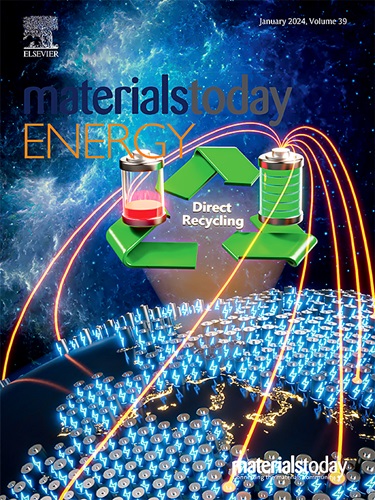带有铜金属活性位点的香港科技大学-1 涂层可实现稳定的锌金属阳极
IF 8.6
2区 材料科学
Q1 CHEMISTRY, PHYSICAL
引用次数: 0
摘要
锌离子水电池(AZIBs)因其独特的优势被认为是大规模储能设备的替代品之一。然而,锌阳极产生的有害锌枝晶严重阻碍了 AZIB 的发展。在此,Cu(BTC) (HKUST-1) 作为裸锌箔表面的紧凑功能界面层,可改善锌沉积/剥离过程的可逆性。有趣的是,HKUST-1 具有高孔隙率、大量水分子空位和铜活性中心,有助于增强 Zn 的扩散动力学并降低 Zn 电极的表面自由能。结合理论计算和实验,HKUST-1 可以促进 Zn[(HO)]的脱溶过程,平衡 Zn 浓度,从而加速 Zn 转移动力学,降低界面能,均匀离子分布。得益于这些优势,HKUST-1@Zn 对称电池在超高电流密度(20 mA/cm 和 20 mAh/cm)条件下可稳定电镀/剥离 250 小时以上。此外,HKUST-1@Zn||MnO 全电池在经过 500 次循环后,放电容量达到 114 mAh/g,显示出更强的长循环性能。所有结果都证明了 HKUST-1 涂层在 AZIB 中的潜在应用。本文章由计算机程序翻译,如有差异,请以英文原文为准。
A HKUST-1 coating with copper metal active site enables stabilized zinc metal anode
Aqueous zinc-ion batteries (AZIBs) are considered to be one of the alternatives for large-scale energy storage devices due to unique advantages. However, the harmful Zn dendrites generation of Zn anodes seriously hinders the development of AZIBs. Herein, Cu(BTC) (HKUST-1) as a compact functional interface layer on the surface of bare Zn foil is shown to improve the reversibility of Zn-plating/stripping process. Interestingly, HKUST-1 possesses high porosity, large number of water molecule vacancies, and Cu active center, which help to enhance the diffusion kinetics of Zn and reduce the surface free energy of Zn electrode. Combining theoretical calculations with experiments, the HKUST-1 can contribute to the desolvation process of Zn[(HO)] and balance Zn concentration, which thus accelerate Zn transfer kinetics, lower interfacial energy, and homogenize ion-distribution. Attributed to these superiorities, the HKUST-1@Zn symmetric cells demonstrate excellent stable plating/stripping for over 250 h under ultra-high current density (20 mA/cm and 20 mAh/cm). Furthermore, a HKUST-1@Zn||MnO full cell exhibits an enhanced long-cycling performance with a discharge capacity of 114 mAh/g after undergoing 500 cycles. All results demonstrate the potential application of HKUST-1 coating in AZIBs.
求助全文
通过发布文献求助,成功后即可免费获取论文全文。
去求助
来源期刊

Materials Today Energy
Materials Science-Materials Science (miscellaneous)
CiteScore
15.10
自引率
7.50%
发文量
291
审稿时长
15 days
期刊介绍:
Materials Today Energy is a multi-disciplinary, rapid-publication journal focused on all aspects of materials for energy.
Materials Today Energy provides a forum for the discussion of high quality research that is helping define the inclusive, growing field of energy materials.
Part of the Materials Today family, Materials Today Energy offers authors rigorous peer review, rapid decisions, and high visibility. The editors welcome comprehensive articles, short communications and reviews on both theoretical and experimental work in relation to energy harvesting, conversion, storage and distribution, on topics including but not limited to:
-Solar energy conversion
-Hydrogen generation
-Photocatalysis
-Thermoelectric materials and devices
-Materials for nuclear energy applications
-Materials for Energy Storage
-Environment protection
-Sustainable and green materials
 求助内容:
求助内容: 应助结果提醒方式:
应助结果提醒方式:


